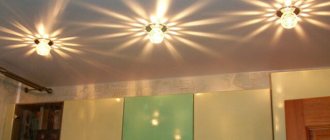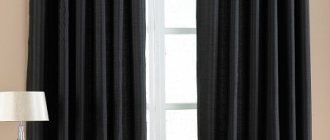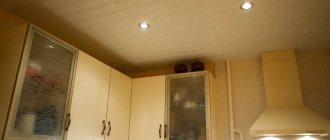Models
There is a wide range of dimmers on the market, which are classified according to different criteria:
- according to the operating principle;
- on the nuances of the design;
- llama compatibility;
- control equipment.
Thermostatic
The lighting was regulated by changing the resistance. As the indicator increases, the current decreases, the lighting dims and vice versa.
This device is characterized by simplicity of design, but different manufacturers have their own components and build quality. Such indicators are important for stable operation and smooth running. The operating principle of thermostat dimmers is to convert light energy into heat. This will not reduce your electricity costs.
Triac dimmers
Devices based on a triac are more modern dimmers. In order for the lamp to light, a current must pass through the device; a voltage is created between the electrodes. The capacitor is charged by potentiometer R, which changes the phase angle.
When a certain value is reached, the triac opens and current flows through it. The resistance drops and the light bulb burns more intensely. The process is effective with any half-waves - positive and negative, so it does not matter where the flow of electrodes goes. Unlike rheostat models, this option is not protected from flicker due to its design.
Dimmer selection
We select a dimmer for the lamps.
- Incandescent lamps - TRIAC triac dimmer. Control from the controller with a 0-10 volt signal or via ModBus. Any lamps.
- LED lamps - transistor dimmer. It's also a trailing edge dimmer. It's also a MOSFET dimmer. Control of a 0-10 volt signal or via ModBus. Lamps must be marked dimmable . This is written on the lamp, on the packaging and on the price tag; such lamps are about twice as expensive as regular lamps.
- LED lamps - depending on the driver dimmability method. It could be TRIAC or 0-10 volts or DALI or something else like DMX. For us, 0-10 volts are most convenient, cheaper and more reliable. TRIAC is more common, but best avoided.
- LED strips - PWM dimmer. Control from the controller with a 0-10 volt signal or via ModBus. It is necessary to take into account the tape current and the dimmer current so that the dimmer does not burn out. If necessary, take an amplifier. Or, if we have a dimmable LED strip power supply, then either 0-10 volts or DALI, depending on the method of dimming the block.
Note 1. To control via ModBus, the Smart Home controller and the dimmer operating via the ModBus protocol must be compatible. That is, the controller had a driver for working with this dimmer. ModBus is not a universal communication language for all automation. Here DALI is a universal protocol; if the controller and driver work via DALI, then they work together. And if they work via ModBus, then they can theoretically work together, the developers just need to write a driver. For example, EasyHomePLC works with RazumDom dimmers. And with ARIES MU and MV modules. But it does not work with WirenBoard modules.
Note 2: It is important to consider the dimmer power. If the dimmer says that it dims 400 watts of resistive load (like the Finder dimmer in the picture above), then for a capacitive load (these are LED lamps) you need to consider 100 watts. On RazumDom dimmers it is written that their power is up to 1000 watts, but these are again incandescent lamps, for LED lamps it is 250-300 watts, no more. If we are talking about dimmable drivers for lamps, then there are no problems, as much as is written on it, such a lamp can be hung, it is also made for an LED lamp.
Note 3. In order not to get confused in concepts, I will explain that the driver, power supply and power source are one and the same. I myself am more accustomed to calling voltage sources power supplies, and current sources for lamps drivers, but this is just my habit.
Note 4. There are 0-10 volts, and there are 1-10 volts. It's the same thing in terms of management. But a driver with 1-10 volt control may, if there is no voltage at the control input, consider that the control cable has fallen off and, depending on its settings, either not turn on at all or always turn on 100%. 1 volt is line control.
Cables
If you have decided on the lamp and the type of dimming, then you need to provide the correct cable.
For incandescent lamps - a 3x1.5 power cable from the switchboard. Or thinner, depending on the power of the lamps.
For LED lamps - also a 3x1.5 power cable from the switchboard. Or thinner, depending on the power of the lamps.
For luminaires with TRIAC control - one 3x1.5 power cable from the switchboard to the driver.
For lamps with 0-10 volt control - a 3x1.5 power cable and a 2-core low-current cable (FTP or ES-04S, it is better to always have spare cores and a screen) from the switchboard to the driver.
For luminaires with DALI control - one 5x1.5 power cable from the switchboard to the driver. Or 3x1.5 and any thin 2-core cable.
For LED strips - a cable corresponding to the current of the strip. Here is an article about Choosing LED strip cables. If the power supply is located at the beginning of the tape, then we supply 230 volts and a control cable there: 3x1.5 and ES-04 or UTP. The number of power cable cores is 2 or 3, depending on the need to ground the lamp body.
Often they want to take the driver of an LED lamp away from the lamp, for example, into a switchboard. This is not always acceptable. Rather, this is almost always unacceptable; the distance should be no more than 2-3 meters. The power supply of the LED strip can be removed from the strip, but the voltage drop in the cable must be taken into account.
A universal option when you don’t know what kind of lamp there will be and how to control it - a 3x1.5 power cable and a low-current shielded cable (twisted pair FTP or signal ES-04S) for controlling 0-10 volts or DALI.
36,899 total views, 239 views today
7+
I design engineering systems for apartments and country houses: electrical, low-current systems, Smart Home.
Please send questions and tasks by email. Found an error in the text?
Select the text with the error and press Ctrl+Enter, it will be corrected by the author.
Related posts:
- Dimming LED lamps I’ll be honest: although I am a supporter of LED lamps, when...
- Cable installation for a Smart Home As I already wrote, the most unreasonable way to save money in construction...
- Controller (PLC) inputs and outputs, discrete and analog Inputs and outputs are the basic concept of any controller. It may…
- Once again about controller inputs and outputs My article about PLC inputs and outputs is one of...
- Once again about the feasibility of solar panels I have received a request for a solar panel system, I would like to…
- What can be installed from a Smart Home Since not everyone understands what a modern…
- What are Modbus and RS-485 - as simple as possible When studying the equipment of Smart Home systems, we constantly come across the mention of...
Dimmer and lamp compatibility
Select dimmers to match the installed lamps.
Almost any device is suitable for halogen models operating on standard voltage. When the voltage decreases, the color of the light flux changes. Minimum levels result in a reddish tint, which is harmful to the eyes.
If the devices are halogen with a voltage of 12-24 V, it is worth looking at the option with a step-down transformer.
Devices for adjusting low-voltage light sources are sensitive to voltage surges, which will lead to a shortened service life.
If the transformer is electronic, then choose a dimmer marked C.
For fluorescent lighting sources, a special device is provided, which is designed to convert the supply frequency of 20-59 kHz. This approach allows you to influence the current strength, as well as the brightness of the light bulbs.
The pulse width modulation method is used to control LED lamps. The power of the light flux is regulated by the duration of the pulses. High frequency prevents lamps from flickering.
Marking of dimming devices
The marking determines the purpose of the devices and their compatibility with lamps:
- The device marked R is suitable for monitoring light in incandescent lamps with Ohm or Resistive loads.
- The L marking assumes operation of the device with transformers, which are used to reduce voltage and inductive loads.
- The model with the designation C is combined with an electronic transformer.
The bulbs also indicate compatibility details.
The principle of operation of a dimmer for LED lamps
Mechanisms for adjusting power function like a rheostat. A change in voltage or current parameter is made as a result of a change in resistance. CVT devices, simple in design, are equipped with a rotary regulator, as well as two contact elements. They are used to adjust the intensity setting of incandescent and halogen light sources.
When these devices went on sale, rheostats were used as dimmers.
They were replaced by semiconductor regulators, in particular:
- triacrum;
- dinistor.
Devices equipped with triacs operate on the principle of using a pulse-width modulation system. These systems have found application in equipment for changing the intensity of the lighting flux of diode lamps. This is possible by changing the signal width and voltage parameter. The option is controlled by a PWM generator.
As for the functions of 12V or 220V devices, they are determined by the design features of the regulators. Simple DIY mechanisms can only be used to change the amount of light intensity. More modern models equipped with circuits are characterized by expanded functionality.
Rostislav Mikhailov spoke in detail about the principle of operation of power regulators for diode lighting elements.
They are used for:
- Fine-tuning lighting fixtures.
- Automatic shutdown of entire groups of lighting devices at a time specified by the consumer, which saves electricity.
- Increasing the service life of lighting sources.
- Ensuring the security of the premises. This is achieved by creating the effect of the presence of the owners. We are talking about a function where the activation and deactivation of lighting devices occurs at a specific time configured by the consumer. If necessary, you can adjust the brightness of the light bulbs.
- Remote control of groups of lighting fixtures. To do this, you can use a remote control, claps, voice commands, or special phone applications.
Advantages and disadvantages of dimmers
The positive qualities of the devices include:
- Comfortable environment for events. The atmosphere can be lit with bright lamps, or for a quiet movie night the lighting can be dimmed.
- Energy consumption is reduced by controlling a group of lamps, which can be easily turned off if necessary.
- The service life of lighting devices increases.
- Multifunctionality of the device - on, off, brightness adjustment.
- Control can be carried out remotely.
- Installation allows you to avoid installing additional lighting sources.
Despite the extensive list of advantages, the devices have disadvantages:
- The mechanism will break if the device is subjected to heavy loads.
- Dimmers are sensitive to temperature changes and fail due to overheating.
- Not compatible with all types of lamps.
Types of modern dimmers
Manufacturers supply the market with a large number of different equipment that can adjust the brightness of the light. Therefore, for convenience, it is divided into types.
First of all, devices are divided according to the type of control, which is as follows:
- Mechanical , sometimes called stationary.
- Electronic - like the previous option, it is a contact type. But instead of regulators and buttons, a sensor is used. This method is modern, effective, informative and quite expensive.
- Acoustic , that is, the brightness of the glow changes as a result of some kind of sound signal that exceeds the noise level set by the user or manufacturer.
- Wireless remote control - a control panel familiar in other areas is used here, as well as smartphones and tablets. In addition, various types of signals can be used, namely infrared, radio.
With a mechanical control method, the homeowner can adjust the brightness of the glow using a push or rotary control - a regulator, buttons, keys. It transmits a signal to a controller installed in the power line.
That is, the procedure is similar to using a regular switch. Some regulators even have controls in the form of familiar keys. This method is effective, simple, and accessible. The only relative disadvantage is the obsolescence of this option, which results in lack of prestige.
The electronic method, apart from being informative, has no other advantages over the mechanical one. But the modern display alone, indicating the necessary information, makes this option more modern and even prestigious, which is the reason for choosing it.
Acoustic dimmers are also a popular control method; in addition, they are affordable and reliable. A significant drawback is the limited modes. There are only a few of them and they are pre-installed. Therefore, it is not a fact that they are ideal for the user.
In addition, there is no guarantee that this option will work correctly, since its acoustic sensor will respond to any signal of sufficient power, and this will not always give the expected result. In this case, the user will not be able to constantly monitor the situation.
As mentioned above, a wireless remote method for controlling the brightness of LED lamps in a home involves the use of some kind of control panel capable of issuing the command:
- via radio channel;
- via infrared channel.
In the first case, control is possible from anywhere in the room, building, and even from outside. This option is practical and effective, but expensive, since such equipment costs a lot.
The infrared remote control also expands the user's capabilities, but requires pointing at the dimmer. Despite the relative disadvantage, this option is more popular - the equipment is more affordable.
In addition, transmission of commands using smartphones and tablets via Wi-Fi is also considered remote control. Often, such a system is also accompanied by a remote control, which increases convenience.
Today, the remote control method is the most functional, as it allows you to unleash the full potential of dimmers for LED strips, spotlights and conventional lamps. Namely, it makes it possible to use energy as economically as possible and increase comfort to the expected level.
In addition, this option allows you to automatically or smoothly turn off/on the lights, simulate the presence of owners in the rooms, and perform any other functions available to regulators.
A potential buyer needs to know that today solutions are increasingly being used that can be controlled using several methods at once. This makes the procedure for adjusting the brightness of lamps more reliable and convenient. The only disadvantage of combined control systems is their considerable cost.
Additionally, all dimmers produced today can be divided according to the installation method.
Which are as follows:
- overhead - such devices are installed instead of conventional switches;
- built-in - they are mounted in a distribution box, a specially made niche;
- modular or panel - their place is on the DIN rail in the electrical panel room, but due to their functionality, performance and high cost, such residential devices are rarely used.
You should know that overhead models are the most popular due to their availability and ease of installation. Practice-tested methods for connecting dimmers are given in our recommended article.
Three main connection schemes
Dimmers can be installed taking into account several schemes.
Rheostat and sensor devices are controlled from one place. In bedrooms they try to use an option with adjustment from two places.
One regulator is installed at the bed, and the second at the entrance. While lying in bed, you can change the brightness of the lighting.
In a large room, you should pay attention to the scheme, where adjustment is carried out from one place, and control is carried out from three. The ideal solution in this case is pass-through lighting controllers.
Dual dimmer
In its design it resembles a regular switch. The left key is responsible for turning the lighting on and off. The second key is responsible for the lighting intensity. To install such a device, you need to take care of the installation socket, the parameters of which directly depend on the light controller itself. Such models are an ideal solution for places with thin partitions, where conventional fixtures simply cannot be accommodated. Such monoblocks have a two-wire connection.
How to connect a smooth lighting transition
A smooth transition of lighting is possible using a dimmer. Devices can be controlled from a remote control or smartphone. In this case, it is possible to adjust the period of time when the light changes from dim to bright. And the presence of cartridges with an adjustable function simplifies the installation process.
The basic principle of the circuit is based on reducing the current when manipulating the device. The main detail of the connection diagram is the use of a capacitor and transistor. The connection diagram is simple and is provided by dimmer manufacturers, or can be found on the Internet.
Compatibility of LED lamps with dimmers
There are no universal regulators; for each type of lighting source, a specific type of dimmer is selected.
Diode lighting sources can be adjustable or unregulated. Light source manufacturers may produce products that function with a specific type of dimmer. To determine compatibility, you can use the tables available from sellers.
It is necessary to select regulators taking into account the technical parameters of the light bulbs:
- If the light source is unregulated, then installing a lamp with a dimmer is not allowed. The result may be poor quality work and breakdown of the regulator itself. Such situations do not apply to warranty service.
- Adjustable light sources can work with standard dimmers operating as a phase cutoff. It must be taken into account that the level of dimming of the light will be influenced by the number of diode elements installed on the switch. Most dimmers require a minimum load level of around 20-45 W to operate properly. To achieve this level of power, you will need one incandescent light bulb. But for installation in a 220 volt network you will need 2-3 diode lamps.
- If one diode light source will be used, it is recommended to give preference to a low voltage dimmer. Such a device is used to change the parameter of low-voltage LED light that has a magnetic transformer device.
Connection options
- Connecting the dimmer to the switch. Wires are connected to the terminals of the device. Installation is carried out at the location of the switch. Upon completion of installation work, the correct operation of the device is tested.
- A switch with a built-in dimmer is no different from a conventional switch installation. The structure is connected to the wiring and fixed.
- The dimmer is connected simultaneously with a simple switch. In this case, additional buttons are simply installed near the bed.
Leading dimmer manufacturers
- The products of the French company Schneider Electric are characterized by their attractive appearance and the quality of the materials used. Such features make the devices popular.
- The German company has been creating electrical equipment for a long time, so light controllers have also appeared in the line. You will be pleased with the functionality, build quality and attractive design.
- Sensors, touch buttons and similar devices are the main products of the Czech company Teco. Dimmers from this manufacturer will delight you with the combination of price and quality.
Dimmers are modern devices that should be installed in every room. This approach will provide comfort and also save on electricity. The range of products will pleasantly surprise the consumer, but it is important to consider compatibility with lamps and connection features. Plan where the fixture will be placed to match the room's design.











